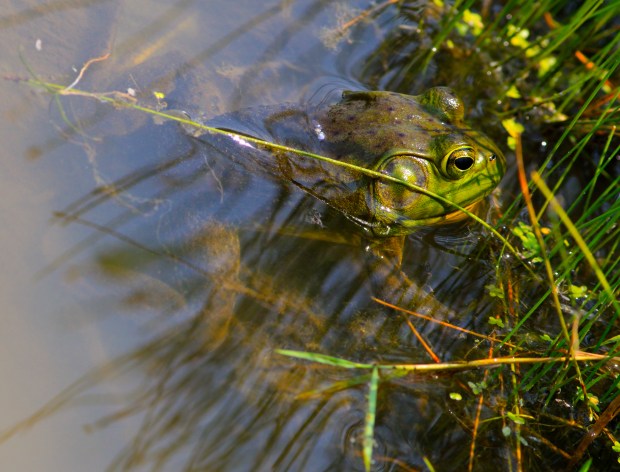Beneath the strawberry moon in late June, we listened to green frogs belting out their banjo-like twang from a pond at Wright Woods near Vernon Hills. It was 10 p.m., and though the forest preserves district closes the gates at night, we had permission to document frog-calling after hours.
Visiting the same woods in early spring, mid-spring and summer offers a glimpse into nature’s ever-changing cycles. In mid-April, as the sun set, we heard an American woodcock, an unusual shorebird that nests in the woods, giving its courtship call. Then we saw it fly into the air in a spiral, then descend twittering its wings, all for the love of a female who was hopefully nearby.
After dark descended, we walked the trail with small, ephemeral ponds that would dry up later in summer. There we heard chorus frogs, which sounded like someone rubbing her fingers across a comb. These were most prominent, but we also heard spring peepers give their little sleigh-bell calls. Both of these frogs are no larger than a thumb, and they are much more often heard than seen. Chorus frogs can be heard in spring even during the daytime, but the spring peepers are nocturnal.
Frogs pass air from their lungs over their vocal cords, which vibrate to produce a sound. Vocal sacs located near the frog’s throat amplify the sound. When a frog inflates its vocal sac, it looks as if it had just produced a giant bubble from chewing gum.
Chorus frogs and spring peepers choose fishless ponds in which to call, mate and breed. Otherwise, fish would devour these tiny frogs and their eggs like mini-sacks.
By mid-May, the peepers have stopped calling, and their songs are replaced by those from American toads, as well as bullfrogs and green frogs just getting started for the summer.
On our next foray, as we waited for dark to come, we heard and observed a state-threatened cerulean warbler give its last song of the day. That bird would not have been singing in the woods in mid-April. At night, we no longer heard peepers and chorus frogs, but rather the whirring din of American toads, which belong to the frog family.
The green frogs and bullfrogs were calling from the large pond where folks fish in the daytime. These frogs are much larger than the peepers. The bullfrog can grow to at least eight inches long, and the green frog up to about 3 inches or so in length.
On that night, as we ventured toward the Des Plaines River in the dark, we heard a young great-horned owl giving its begging calls in the distance. By mid-May, great horned owls have already fledged young and are now teaching them how to find food on their own.
In late June, we entered the preserve just after the periodical cicadas had ended their daytime mating songs. We saw some here and there on leaves or on the ground, but the grand spectacle folks have been seeing this year of these insects that come out every 17 years from the ground was nearly over.
We walked our survey trail and heard a barred owl give its “who cooks for you, who cooks for you all” call.
That evening, we hoped to hear gray tree frogs calling. This was their time to call. We didn’t hear those, but we did hear more green frogs and bullfrogs. There seemed to be more of them and they were calling more frequently than at our last survey.
Since at least 2013, amphibian populations, including those of frogs, have been declining worldwide by nearly 4%. In northern Illinois, we’ve lost the once common cricket frog, which gives an interesting sound as if someone were tapping two stones together. They still call in central Illinois, but no longer up here, and scientists aren’t quite sure why, although in general climate change, loss of habitat and disease are contributing to amphibian populations worldwide.
At the end of our final survey, we walked to the pond and stood quietly beneath the full moon listening to the “jug-a-rum” calls of the bullfrogs and the banjo twang of the green frogs. Being outdoors at night listening to frogs and owls makes you feel as if you were out in the wilderness even when busy streets are nearby.
It is an otherworldly experience every child and adult should have.
Sheryl DeVore has worked as a full-time and freelance reporter, editor and photographer for the Chicago Tribune and its subsidiaries. She’s the author of several books on nature and the environment. Send story ideas and thoughts to sheryldevorewriter@gmail.com.





